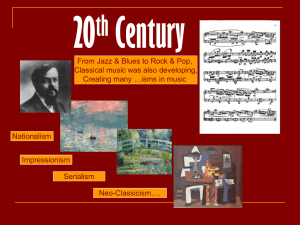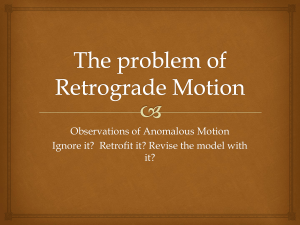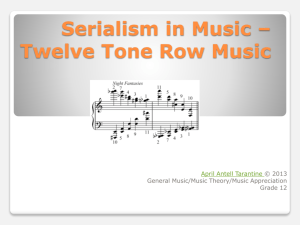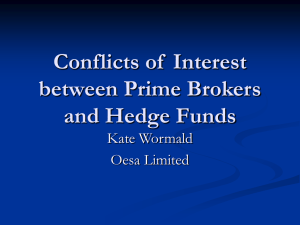Document
advertisement
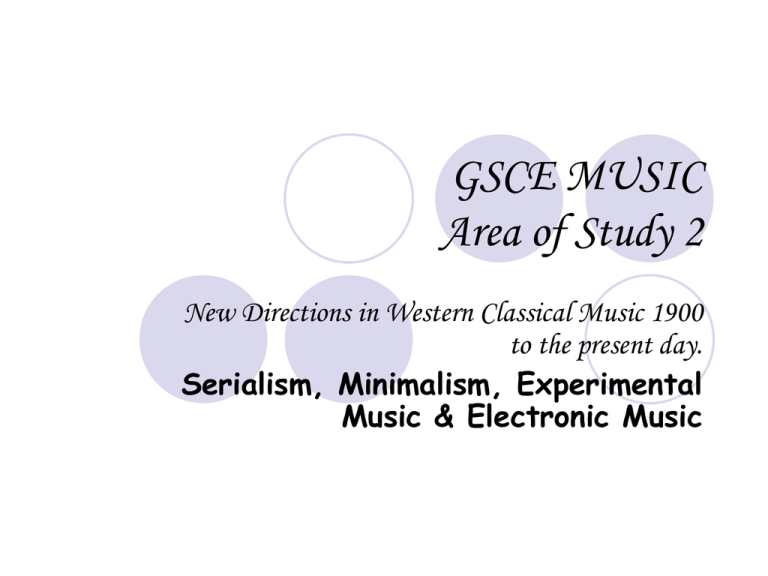
GSCE MUSIC Area of Study 2 New Directions in Western Classical Music 1900 to the present day. Serialism, Minimalism, Experimental Music & Electronic Music Serialism Since the Baroque period harmony had been progressing and became more and more complex. In the late Romantic period composers such as Wagner, Bruckner and Strauss (Richard) were using more chromatic notes and more dissonant chords. In France composers such as Debussy (1862-1918) were part of a new way of thinking, ‘Impressionism’. The word first applied to a a school of French painting that flourished from about 1880 to the end of the century. Its chief representative was Claude Monet. Impressionism tried to either give a glimpse, an impression of something, not a concrete view. Unlike earlier program music, impressionism did not seek to express deeply felt emotions but evoke a mood, a fleeting sentiment, an atmosphere. The tonality was not so defined and did not have a definite ‘key centre’. Serialism Out of impressionism came ‘Expressionism’ (around 1910 and onwards), another painting term. Expressionism sought to represent inner experience and was a rebellion against established order and accepted forms; real objects in a distorted representation –artists reflecting feelings about surroundings and themselves. Artists created vivid pictures, distorting colour and shape to express their innermost emotions. In the same way, composers poured intense emotional expression into their music. Expressionist music avoided cadence, repetition, sequence or balanced phrases. It had constantly changing textures, extremes of dynamics and used harmonic and melodic distortion and dissonance for effect. The term ‘Atonal’ music is from this period and means music that is not based on harmonic and melodic relationships revolving round a key centre. In the 1920’s Arnold Schoenberg made up a completely different way of composing called Serialism . Remember – in this period of history there were two of the most horrific wars the world has ever seen. Composers of Serialism 1. He 2. He 3. He The three main composers of Serialism are: Arnold Schoenberg – 1874-1951. inverted Serialism. As a Jew he was obliged to leave Berlin in 1933 and went to live in Paris and then America. He composed in many different styles. Alban Berg – 1885-1935. was a pupil of Schoenberg and was in the Austrian army in WW1. He also composed in other styles. His serial compositions are sometimes considered to be the best of the three composers. Anton Webern – 1883 – 1945. was also a pupil of Schoenberg. He was shot dead at the end of the war by mistake. He was probably the most committed to Serialism and did not compose in any other way. His acknowledged compositions last about three hours in total. He often distributed his melodic lines among different instruments which gave the listener ‘flashes’ of melody. Serialism Schoenberg developed a new way of thinking about harmony and a new way of composing. He treated all 12 notes of the scale as equal to each other. The main points of this new way of composing were: 1. The basis of each composition is a row (or series) consisting of the 12 tones of the octave arranged how the composer likes. 2. The tones of the series may be used both successively ( a melody) and simultaneously (as harmony or counterpoint), in any octave and with any desired rhythm. 3. The row may not only be used in its ‘Prime’ form but in inverted form (upside down), retrograde (backwards) for or retrograde inverted form (upside down and backwards), and in transpositions of any of the four forms. 4. The notes may appear singly or in combination (chords) but they must appear in the correct order and no notes may be used again until all the other have been used once. 5. Notes can appear in any octave and this is part of the style. The composers used all twelve pitches of the series before going on to use the series in any of its forms again. There is such a thing as ‘Total Serialism’ where it is not just the twelve tones which are the same but the duration, timbre and texture. Composing A scale has 12 notes in it and we are going to use the scale starting on C. Imagine that rather than note names we use the numbers 1-12. In your bags you have the numbers 1-12 with the note names as well. In your groups pick out all the numbers and put them in any order you like…what you have now is your ‘prime order’. Now you have your ‘prime order’ you have to decide on a rhythm… • In your groups play your ‘prime order’ until you can play it without any mistakes • Perform your ‘prime order’ to the rest of the class. Your composition will be a bit boring if we just have the ‘prime order’ so we’ll change it a bit. 1. Backwards (retrograde) 2. Upside down (inversion) 3. Upside down and backwards (retrograde inversion). Upside down (inversion) In order to play your ‘prime order’ upside down you have to work out the gaps in between the notes, they are called intervals. For example, if in our ‘prime order’ we started on 1, C and then went up to 8,G the gaps in between the notes (including C) is…8. 8 notes down from 1, C is…6, F… do you understand?! Composing In order to make your composition sound interesting you might want to… 1. Play your ‘prime order’ on different instruments. 2. Play your ‘prime order’ and variations at the same time. 3. Play it as a canon, or round (one person starts and then the next and so on). 4. Start the whole thing on a different note, on G for example. 5. Add in dynamics (loud and soft).
